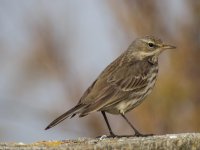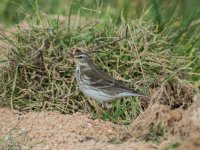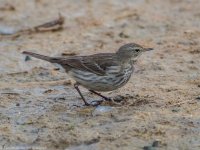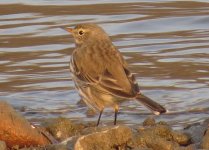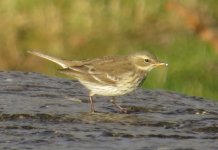-
Welcome to BirdForum, the internet's largest birding community with thousands of members from all over the world. The forums are dedicated to wild birds, birding, binoculars and equipment and all that goes with it.
Please register for an account to take part in the discussions in the forum, post your pictures in the gallery and more.
You are using an out of date browser. It may not display this or other websites correctly.
You should upgrade or use an alternative browser.
You should upgrade or use an alternative browser.
Water pipits (Central Spain)? (1 Viewer)
- Thread starter fdokykcu
- Start date
More options
Who Replied?MTem
Well-known member
First one looks like a Rock pipit to me, although the location would suggest otherwise from what I understand of winter distribution. The side tail feathers look buff, not white. The wing bars and super look buff and less defined, and the bill looks long. Hmmm
Second definitely a Water pipit, third probably, but it doesn't look as clearly marked as I'd expect - not sure of other options though.
Best wait for an expert!
Mick
Second definitely a Water pipit, third probably, but it doesn't look as clearly marked as I'd expect - not sure of other options though.
Best wait for an expert!
Mick
Last edited:
Brian J Small
Well-known member
and me. Note the slight warmth to the brown rump uppertail coverts, wich are olive/brown grey on Rock - http://i89.photobucket.com/albums/k217/squidfish_2006/Blog photos/rock-pipit-3-2009.jpg
Brian S
Brian S
Jane Turner
Well-known member
I don't think I dreamt this up (though its possible) but I'm sure I heard/read that there was a population of Rocky coast breeding pipits that looked more like Water. I think it was Galicia.
I always meant to see if I could find out what they looked like
I always meant to see if I could find out what they looked like
Last edited:
Brian J Small
Well-known member
I don't think I dreamt this up (though its possible) but I'm sure I heard/read that there was a population of Rocky coast breeding pipits that looked more like Water. I think it was Galicia
I don't think so. NW France is closest Rock Pipit breed.
What might be interesting is my notes from breeding Water Pipits in the Pyrenees and the Alps. I have sometimes noticed that breeding birds in the Pyrenees have slightly broader streaks on average on the breast sides and flanks than those I see in the Alps. This may account for WPs that seem to have broader streaking in winter? Food for thought and further research maybe (or not).
Brian S
Jane Turner
Well-known member
My memory was that were treated as Water Pipits but might not have been and the discussion was having as on the lines of whether breeding behaviour/location/habits dictated plumage or vice versa
Last edited:
What might be interesting is my notes from breeding Water Pipits in the Pyrenees and the Alps. I have sometimes noticed that breeding birds in the Pyrenees have slightly broader streaks on average on the breast sides and flanks than those I see in the Alps. This may account for WPs that seem to have broader streaking in winter? Food for thought and further research maybe (or not).
A few years ago, a friend and I saw a stunning breeding plumage Water Pipit at Pilmore in east Co. Cork (the bird had wintered there, we didn't find it, but it had moulted into breeding plumage by then). A week or two later, we, and some other friends, were in NE Spain, and the breeding Water Pipits we saw in the Pyrenees were duller and more streaked than the bird we'd seen back home (which presumably came from the Alps or some other mountain range, given that Pyrenean birds would only have to descend to lower altitudes to find an equitable climate and would perhaps be less likely to wander too far?).
MTem
Well-known member
Well all I can add is that if I saw the bird in photo 1 on the south coast of the UK I would have it down as a Rock pipit 100% - and I think I wouldn't be alone. I can see only features that point in that direction (dull brown rump, streaked back in addition to those stated above) and none in the other. I have compared it with the Rock pipit photos I have and the ONLY feature that differs is the legs on this bird are really dark brown, whereas in my photos they are only mid-dark brown..... if anything a pointer towards Rock vs. Water as I understand it.
The few Water pipits I've seen in the UK looked like photo 2.
Given Little auks turn up in central England is it not possible that a vagrant Rock pipit can turn up in Central Spain?
Genuinely intrigued .....and willing to be educated.
Mick
The few Water pipits I've seen in the UK looked like photo 2.
Given Little auks turn up in central England is it not possible that a vagrant Rock pipit can turn up in Central Spain?
Genuinely intrigued .....and willing to be educated.
Mick
Jane Turner
Well-known member
I agree - in at least I'd have trouble accepting this as a safe Water Pipit in a situation where that was the rarer option. With so many overlapping features you'd want to see brighter white wing bars and pure white outers at least. Call and T5 pattern would help. Without them and the worry that cameras are very good at messing up brown tones I'd have to bottle it and leave it unidentified.
*One thing I can just about pick up is that the rump looks the same tone as the lesser coverts to me - whereas on the two undoubted Waters above the rump is clearly browner
Obviously this is a bird on its breeding grounds - but this litt has a pretty brown rump (when compared in tone to the lesser coverts as in in photo colour match)
http://fbo.org.uk/wp-content/uploads/2014/03/littoralis-on-breeding-ground-in-scanindinaviaa.jpg
*One thing I can just about pick up is that the rump looks the same tone as the lesser coverts to me - whereas on the two undoubted Waters above the rump is clearly browner
Obviously this is a bird on its breeding grounds - but this litt has a pretty brown rump (when compared in tone to the lesser coverts as in in photo colour match)
http://fbo.org.uk/wp-content/uploads/2014/03/littoralis-on-breeding-ground-in-scanindinaviaa.jpg
Last edited:
I'll do my best to translate the text of the "Atlas of Wintering birds in Spain 2007-2010" by the Spanish Birding Society S.E.O., where Rock pipit is treated as a regular, but not common, wintering species (they don´t give in the text the specific data gathered for the species, nor a distribution map)
"During the field work for the Atlas a low number of rock pipits observations had been registered. There could be two reasons for this (not excluding one each other): (a) it has been confused with other pipits (b) the number of wintering birds in Iberia is really low. Due to the scarce number of sightings it is not possible either to suggest a general distribution pattern or to estimate the numbers of its wintering population. Nonetheless the data suggest that its distribution is not limited to littoral areas, but it can be found far from the coastline, even hundreds of kilometres.
It is not possible with these data to establish general habitat selection patterns. Observations in the Cantabric and Galician coasts suggest that uses similar habitats to those in which they breed in northern Europe, that is, intermareal rocky areas.
The species seems to be more flexible in its habitat selection during winter. This would explain its detection in coastal wetlands of Catalonia (Burgas-Riera en Herrando et al., 2011) and in inner areas of the Iberian peninsula . It is highly probable that here the Rock pipit will be closely associated to reservoirs, rivers, or continental water-bodies in general.
The species doesn't breed in Spain, so the sightings should belong to birds from breeding populations in northern countries -in principle from NW Europe- which supposedly winter in the Mediterranean area, including Spain (Biber in Hagemeiger & Blair, 1997). Alström et al. (2003) say that populations breeding in Scandinavia and Russia could reach southern and southeastern Europe in their migrations. Ringed birds data is rare: there's only one recaptured bird in Spain in winter (MARM, 2011) which had been ringed during spring in Sweden."
So, although every winter dark leg pipit in inner Spain is usually disregarded as Rock pipit in grounds of distribution, may be some deserve a second look. In my case I'm not experienced enough, that's why I asked
Thanks by your very interesting comments
"During the field work for the Atlas a low number of rock pipits observations had been registered. There could be two reasons for this (not excluding one each other): (a) it has been confused with other pipits (b) the number of wintering birds in Iberia is really low. Due to the scarce number of sightings it is not possible either to suggest a general distribution pattern or to estimate the numbers of its wintering population. Nonetheless the data suggest that its distribution is not limited to littoral areas, but it can be found far from the coastline, even hundreds of kilometres.
It is not possible with these data to establish general habitat selection patterns. Observations in the Cantabric and Galician coasts suggest that uses similar habitats to those in which they breed in northern Europe, that is, intermareal rocky areas.
The species seems to be more flexible in its habitat selection during winter. This would explain its detection in coastal wetlands of Catalonia (Burgas-Riera en Herrando et al., 2011) and in inner areas of the Iberian peninsula . It is highly probable that here the Rock pipit will be closely associated to reservoirs, rivers, or continental water-bodies in general.
The species doesn't breed in Spain, so the sightings should belong to birds from breeding populations in northern countries -in principle from NW Europe- which supposedly winter in the Mediterranean area, including Spain (Biber in Hagemeiger & Blair, 1997). Alström et al. (2003) say that populations breeding in Scandinavia and Russia could reach southern and southeastern Europe in their migrations. Ringed birds data is rare: there's only one recaptured bird in Spain in winter (MARM, 2011) which had been ringed during spring in Sweden."
So, although every winter dark leg pipit in inner Spain is usually disregarded as Rock pipit in grounds of distribution, may be some deserve a second look. In my case I'm not experienced enough, that's why I asked
Thanks by your very interesting comments
Well all I can add is that if I saw the bird in photo 1 on the south coast of the UK I would have it down as a Rock pipit 100% - and I think I wouldn't be alone. I can see only features that point in that direction (dull brown rump, streaked back in addition to those stated above) and none in the other. I have compared it with the Rock pipit photos I have and the ONLY feature that differs is the legs on this bird are really dark brown, whereas in my photos they are only mid-dark brown..... if anything a pointer towards Rock vs. Water as I understand it.
The few Water pipits I've seen in the UK looked like photo 2.
Given Little auks turn up in central England is it not possible that a vagrant Rock pipit can turn up in Central Spain?
Genuinely intrigued .....and willing to be educated.
Mick
Last edited:
Tib78
Well-known member
Regarding bird 1: I see a brown-mantled/rumped pipit (no grey nor olive tones) with black legs (no dull pinkish tinge), clean whitish underparts, flank marking not really cloudy/smudgy...in Central Spain.
I think common sense dictates it shoud be labelled as a Water pipit.
I think common sense dictates it shoud be labelled as a Water pipit.
About the rump colour I uploaded pictures of two different Water Pipits from Bulgaria, taken in December, 2015.
Actually, I don`t remember any Water Pipit with such good difference between rump and mantle in the winter season here.
Actually, I don`t remember any Water Pipit with such good difference between rump and mantle in the winter season here.
Attachments
Users who are viewing this thread
Total: 2 (members: 0, guests: 2)




